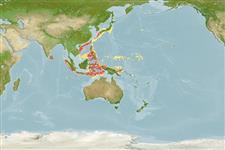Classification / Names
Common names from other countries
Main reference
Size / Weight / Age
Max length : 9.0 cm TL male/unsexed; (Ref. 559)
Environment
Marine; bathydemersal; depth range 200 - 500 m (Ref. 9771)
Climate / Range
Deep-water, preferred ?
Distribution
Short description
Dorsal
spines
(total): 6 - 8;
Dorsal
soft rays
(total): 18-21;
Anal
soft rays: 18 - 19. This species is characterized by the following: fusiform body covered with bony plates with head large and depressed; broad snout, with short, triangular rostral projection on each side, nearly parallel to each other; interorbital region concave and with no distinct ridges; head with supraocular, parietal, posttemporal, opercular, and preopercular spines; large and inferior mouth with posterior tip of upper jaw reaching point below anterior border of orbit; upper jaw with villiform teeth; no teeth on lower jaw, vomer and palatine; 1-2 short barbels on lip, none on chin; body plates arranged in 4 rows, each plate with single, posteriorly directed spine; plates in upper lateral row lack anteriorly directed spine; anterior 4 (or 5) plates small; lower lateral row of bony plates ending at caudal peduncle and separated from the other side; 4 (or 5) plates along ventral region anterior to anus, with the most anterior largest; dorsal fin origin between first and second bony plates in dorsal row, ending on anterior part of caudal peduncle; anal fin origin just posterior to anus, also terminating on anterior part of caudal peduncle; pectoral fin reaching posteriorly to near anus length; 2 ventralmost pectoral fin rays detached, large and thickened; pelvic fin reach posteriorly to point between origin of dorsal and anus fins; when fresh, colour of head and dorsal part of body pale red, ventral part of body whitish; dorsal part with yellowish-green spots; fins mostly whitish; 2 dusky bands on pectoral fin (Ref. 93670).
IUCN Red List Status (Ref. 115185)
Threat to humans
Harmless
Human uses
Fisheries: of no interest
More information
Common namesSynonymsMetabolismPredatorsEcotoxicologyReproductionMaturitySpawningFecundityEggsEgg development
Age/SizeGrowthLength-weightLength-lengthLength-frequenciesMorphometricsMorphologyLarvaeLarval dynamicsRecruitmentAbundance
ReferencesAquacultureAquaculture profileStrainsGeneticsAllele frequenciesHeritabilityDiseasesProcessingMass conversion
Tools
Special reports
Download XML
Internet sources
Estimates of some properties based on models
Phylogenetic diversity index
PD50 = 1.0000 many relatives (e.g. carps) 0.5 - 2.0 few relatives (e.g. lungfishes)
Trophic Level
3.3 ±0.3 se; Based on size and trophs of closest relatives
Resilience
High, minimum population doubling time less than 15 months (Preliminary K or Fecundity.)
Vulnerability
Low vulnerability (19 of 100)
Price category
